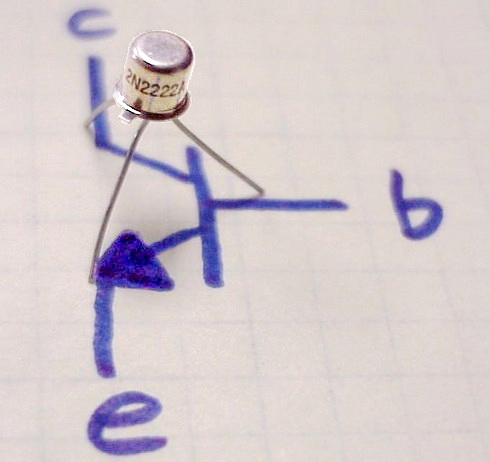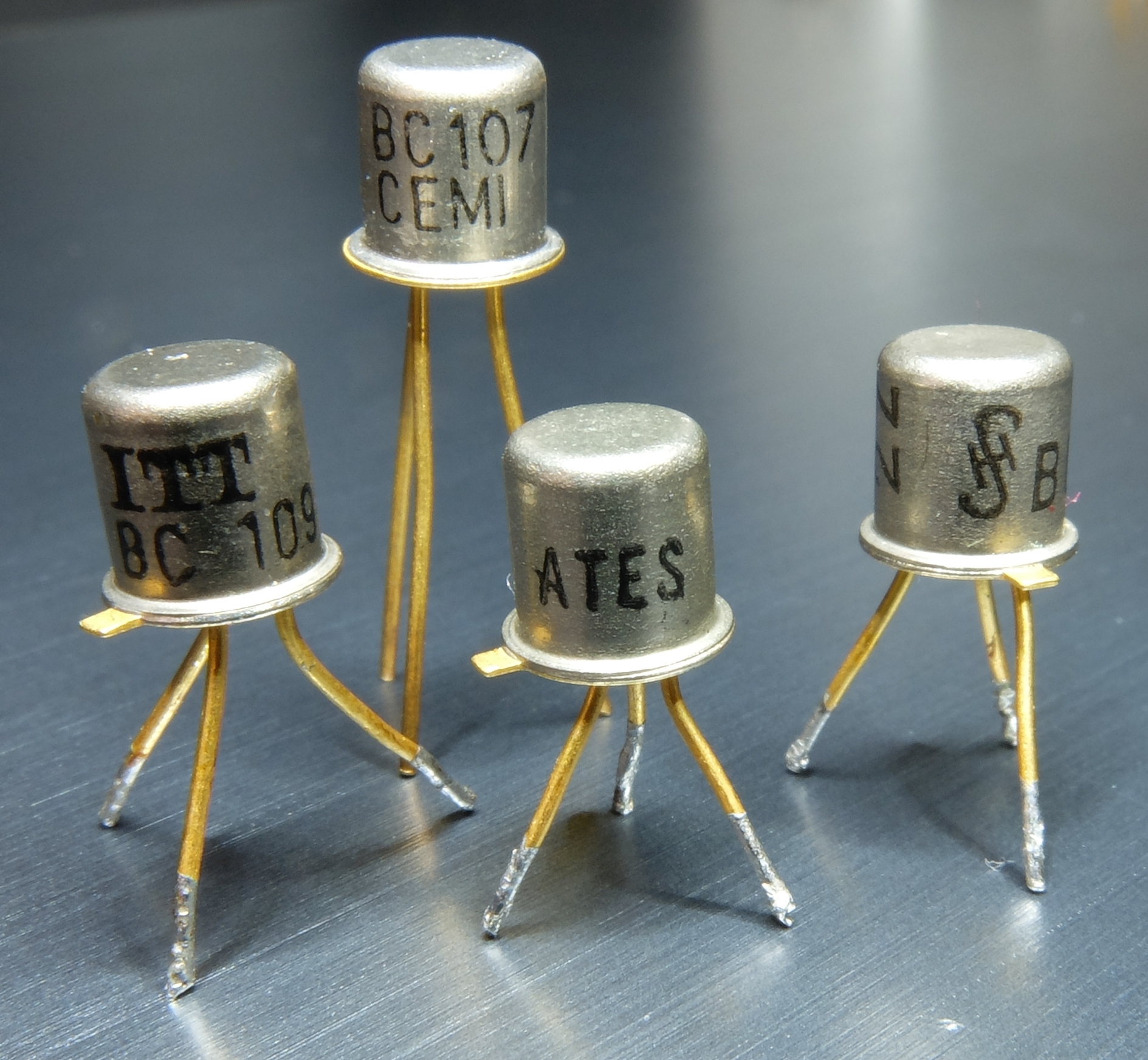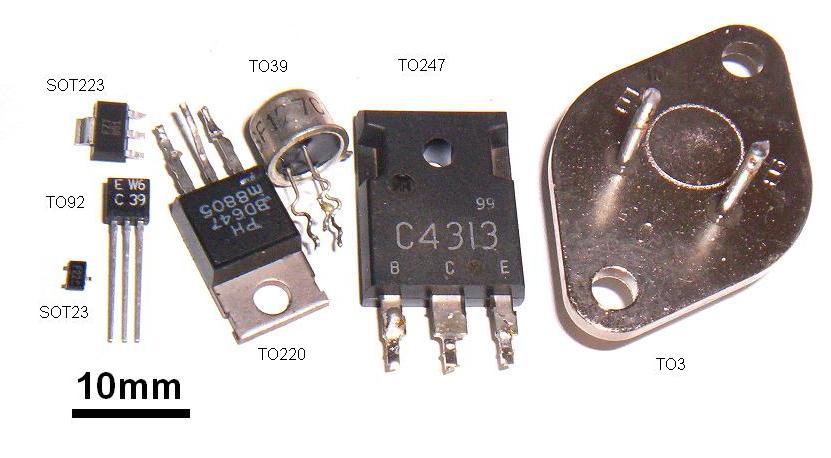|
2N2907
The 2N2907 is a commonly available PNP bipolar junction transistor used for general purpose low-power amplifying or switching applications. It is designed for low to medium current, low power, medium voltage, and can operate at moderately high speeds. This transistor was made by several manufacturers; Texas Instruments released a data sheet for their version of this part dated March 1973. An "A" suffix indicates a slightly higher breakdown voltage. These transistors have an enduring popularity with electronics hobbyists. Specifications It is a 0.6-ampere, 60-volt, 400-milliwatt transistor. Its transition frequency (where the current gain drops to one) under specified test conditions is 200 Megahertz. At low frequencies, the current gain (beta) is at least 100. The 2N2907 is used in a variety of analog amplification and switching applications. Part numbers The 2N2907 (PNP) and 2N2222 (NPN) are complementary transistor pairs. Other types of transistors with different properties a ... [...More Info...] [...Related Items...] OR: [Wikipedia] [Google] [Baidu] |
2N2222
The 2N2222 is a common NPN bipolar junction transistor (BJT) used for general purpose low-power amplifying or switching applications. It is designed for low to medium current, low power, medium voltage, and can operate at moderately high speeds. It was originally made in the TO-18 metal can as shown in the picture. The 2N2222 is considered a very common transistor, and is used as an exemplar of an NPN transistor. It is frequently used as a small-signal transistor, and it remains a small general purpose transistor of enduring popularity. The 2N2222 was part of a family of devices described by Motorola at a 1962 IRE convention. Since then it has been made by many semiconductor companies, for example, Texas Instruments.''The Transistor and Diode Data Book for Design Engineers'', Texas Instruments Incorporated, no date, TI publication number CC413 71242-73-CSS, page 4-93 Specifications The JEDEC registration of a device number ensures particular rated values will be met by a ... [...More Info...] [...Related Items...] OR: [Wikipedia] [Google] [Baidu] |
BC548
The BC548 is a general-purpose NPN bipolar junction transistor commonly used in European and American electronic equipment. It is notably often the first type of bipolar transistor hobbyists encounter and is often featured in designs in hobby electronics magazines where a general-purpose transistor is required. The BC548 is low in cost and widely available. History and usage The BC548 is a part of a family of NPN and PNP epitaxial silicon transistors that originated with the metal-cased BC108 family of transistors. The BC548 is the modern plastic-packaged BC108; the BC548 article at the Radiomuseum website describes the BC548 as a successor to the BC238 and differing from the BC108 in only the shape of the package. Datasheets for the BC548 give specifications that are identical to, or exceed, those of the BC108, BC148 and BC238 predecessors. Thus the BC548 (or BC546 to 550) is a valid substitute in any circuit designed for the older BC108 (or BC148), which includes many Mullard a ... [...More Info...] [...Related Items...] OR: [Wikipedia] [Google] [Baidu] |
BC108 Family
The BC107, BC108 and BC109 are general-purpose low power silicon NPN bipolar junction transistors found very often in equipment and electronics books/articles from Europe, Australia and many other countries from the 1960s. They were created by Philips and Mullard in 1963 and introduced in April 1966. Initially in metal (TO-18) packages, the range expanded over time to include other package types, higher voltage ratings, and a better selection of gain (hFE and hfe) groupings, as well as complementary BC548#Complementary pairs, PNP types. Some manufacturers have specified their parts with a higher power dissipation rating (Ptot) than others. The BC548 is an example of the modern low-cost member of this family, still in a through-hole package, while the BC848 is the Surface-mount technology, surface-mount version. Table of BC107 to BC860 variants (See alsofor a neat summary of some of the family). Noise figure (at 1 kHz, for a 2 kilohm source, BW = 200 Hz, IC=0.2 mA ... [...More Info...] [...Related Items...] OR: [Wikipedia] [Google] [Baidu] |
2N3906
The 2N3906 is a commonly used PNP bipolar junction transistor intended for general purpose low-power amplifying or switching applications. It is designed for low electric current and power and medium voltage, and can operate at moderately high speeds. It is complementary to the 2N3904 NPN transistor. Both types were registered by Motorola Semiconductor in the mid-1960s. Device packaging and specifications The 2N3906 is manufactured in a plastic TO-92 case. When looking at the flat side with the leads pointed downward, the three leads emerging from the case are, from left to right, the emitter, base, and collector leads. The 2N3906 is specified by a collector current of 200 mA, collector-base and collector-emitter voltages of 40 V, for power dissipation of 300 mW. Its transition frequency Ft is 250 MHz, with a beta of at least 100. Part numbers The 2N3904 (NPN) and 2N3906 (PNP) are complementary transistor pairs. These transistors are available in package styles TO-92, ... [...More Info...] [...Related Items...] OR: [Wikipedia] [Google] [Baidu] |
2N3904
The 2N3904 is a common NPN bipolar junction transistor used for general-purpose low-power amplifying or switching applications. It is designed for low current and power, medium voltage, and can operate at moderately high speeds. It is complementary to the 2N3906 PNP transistor. Both types were registered by Motorola Semiconductor in the mid-1960s. Device packaging and specifications The construction of the 2N3904 and 2N3906 in the 1960s represented a significant performance and cost improvement, with the plastic TO-92 case replacing metal cans. This transistor is a low-cost device, widely available and sufficiently robust to be of use by experimenters and electronics hobbyists. When looking at the flat side with the leads pointed downward, the three wires emerging from the bottom are connected to, from left to right, the emitter, the base and the collector. Some manufacturers mark "EBC" on the molded part, but all are required to have those connections for a part which is ... [...More Info...] [...Related Items...] OR: [Wikipedia] [Google] [Baidu] |
Bipolar Junction Transistor
A bipolar junction transistor (BJT) is a type of transistor that uses both electrons and electron holes as charge carriers. In contrast, a unipolar transistor, such as a field-effect transistor (FET), uses only one kind of charge carrier. A bipolar transistor allows a small current injected at one of its terminals to control a much larger current between the remaining two terminals, making the device capable of amplification or switching. BJTs use two p–n junctions between two semiconductor types, n-type and p-type, which are regions in a single crystal of material. The junctions can be made in several different ways, such as changing the doping of the semiconductor material as it is grown, by depositing metal pellets to form alloy junctions, or by such methods as diffusion of n-type and p-type doping substances into the crystal. The superior predictability and performance of junction transistors quickly displaced the original point-contact transistor. Diffused trans ... [...More Info...] [...Related Items...] OR: [Wikipedia] [Google] [Baidu] |
KT315
The KT315 is a Soviet silicon NPN bipolar junction transistor used for general-purpose low-power amplifying or switching applications, enclosed in the plastic KT-13 package. It was widely used in Soviet electronic equipment. The KT361 is a complementary ( PNP) for the KT315 transistor, so it was often paired with it in push-pull stages. KT315 and KT361 transistors became the first in the USSR, which were produced using planar technology. The characteristics achieved in the KT315 were groundbreaking in Soviet technology at that time. The process of manufacturing was much cheaper than the alloy-junction technology, and the parameters surpassed those of earlier transistor types, in particular, the unity-gain frequency was 250 MHz. The people associated with the development and mass-production launch of the KT315 were awarded the USSR State Prize for it in 1973. Application KT315 transistors were designed for use in high-, medium- and sound-frequency amplifying stages ... [...More Info...] [...Related Items...] OR: [Wikipedia] [Google] [Baidu] |
2N3055
The 2N3055 is a silicon NPN power transistor intended for general purpose applications. It was introduced in the early 1960s by RCA using a hometaxial power transistor process, transitioned to an epitaxial base in the mid-1970s. Its numbering follows the JEDEC standard. It is a transistor type of enduring popularity. Specifications The exact performance characteristics depend on the manufacturer and date; before the move to the epitaxial base version in the mid-1970s the fT could be as low as 0.8 MHz, for example. Packaged in a TO-3 case style, it is a 15 amp, 60 volt (or more, see below), 115 watt power transistor with a β (forward current gain) of 20 to 70 at a collector current of 4 A (this may be over 100 when testing at lower currents). It often has a transition frequency of around 3.0 MHz and 6 MHz is typical for the 2N3055A; at this frequency the calculated current gain (beta) drops to 1, indicating the transistor can no longer provide us ... [...More Info...] [...Related Items...] OR: [Wikipedia] [Google] [Baidu] |
Small-outline Transistor
A small outline transistor (SOT) is a family of small footprint, discrete surface mount transistor commonly used in consumer electronics. The most common SOT are SOT23 variations,. link froamkor.com/packaging/leadframe/sot23-tsot/ref> SOT23-5 differs from SOT23 in a wider body of instead of . Also, manufacturers offer the nearly identical thin small outline transistor (TSOT/TSOP) package, where lower height is important. SOT23, SOT323, SOT416 The SOT23 package is very popular and a common package for transistors, as well as diodes and voltage regulators. SOT23-5, SOT353, SOT553 SOT23-6, SOT363, SOT563 SOT23-8 SOT54 SOT54 is an alternate designation for the JEDEC TO-92 package. SOT23-4, SOT143, SOT343 SOT490 SOT89-3 The SOT89-3 electrically only has three leads (contact/pin). The wide lead (tab) is physically part of the middle lead on the other side of the package. Some call this package a SOT89-4, since it visually appears to have four leads when look ... [...More Info...] [...Related Items...] OR: [Wikipedia] [Google] [Baidu] |
TO-92
The TO-92 is a widely used style of semiconductor package mainly used for transistors. The case is often made of epoxy or plastic, and offers compact size at a very low cost. History and origin The JEDEC TO-92 descriptor is derived from the original full name for the package: Transistor Outline Package, Case Style 92. The package is also known by the designation Small-outline transistor#SOT54, SOT54. By 1966 the package was being used by Motorola for their 2N3904 devices among others. Construction and orientation The case is molded around the transistor elements in two parts; the face is flat, usually bearing a machine-printed part number (some early examples had the part number printed on the top surface instead). The back is semi-circularly-shaped. A line of moulding flash from the injection-moulding process can be seen around the case. The leads protrude from the bottom of the case. When looking at the face of the transistor, the leads are commonly configured from left-to- ... [...More Info...] [...Related Items...] OR: [Wikipedia] [Google] [Baidu] |
TO-18
In electronics, TO-18 is a designation for a style of transistor metal case. The case is more expensive than the similarly sized plastic TO-92 package. The name is from JEDEC, signifying ''Transistor Outline Package, Case Style 18''. Construction and orientation The typical TO-18 metal can package has a base diameter of , a cap diameter of , a cap height of . The tab is located 45° from pin 1, which is typically the emitter. The lead diameter is nominally . The leads are arranged in a circle with a diameter of . The minimum length of the leads is . Different manufacturers have different tolerances, and the actual form factor may vary slightly, depending on function. Uses and variants The 3-lead TO-18 is used for transistors and other devices using no more than three leads. Variants for diodes, photodiodes and LEDs may have only two leads. Light-sensitive or light-emitting devices have a transparent window, lens, or parabolic reflectors in the top of the case rather than a sea ... [...More Info...] [...Related Items...] OR: [Wikipedia] [Google] [Baidu] |
Surface-mount Device
Surface-mount technology (SMT), originally called planar mounting, is a method in which the electrical components are mounted directly onto the surface of a printed circuit board (PCB). An electrical component mounted in this manner is referred to as a surface-mount device (SMD). In industry, this approach has largely replaced through-hole technology construction method of fitting components, in large part because SMT allows for increased manufacturing automation which reduces cost and improves quality. It also allows for more components to fit on a given area of substrate. Both technologies can be used on the same board, with the through-hole technology often used for components not suitable for surface mounting such as large transformers and heat-sinked power semiconductors. An SMT component is usually smaller than its through-hole counterpart because it has either smaller leads or no leads at all. It may have short pins or leads of various styles, flat contacts, a matrix of ... [...More Info...] [...Related Items...] OR: [Wikipedia] [Google] [Baidu] |








